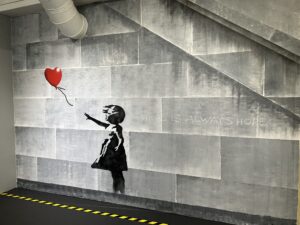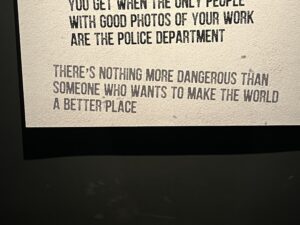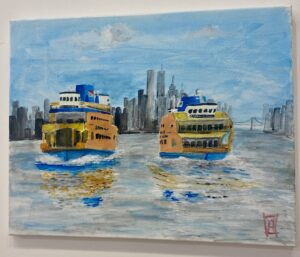My trip to visit the museum was alright but the weather was not too great. I did end up going with friends since we went to Soho right after so it lightened the mood. I went into this museum with an open mind because it was fascinating that a graffiti artist could create impactful art.
This is actually my second time writing this blog because the first time the website crashed on me and nothing saved so… take two on my phone this time.

The first art piece at the Banksy Museum that caught my attention was one that was seen in Ukraine. This piece showed the reality of the situation in the war. The ordinary appearance of the woman as she is depicted to be in a bathrobe and the addition of the mask and extinguisher reveals the idea that Russia is intruding into the lives of ordinary people. Furthermore, it symbolizes the dangers faced by civilians and the need for safety amidst chaos. The fire extinguisher is an interesting pick for a tool because it can not be used as a weapon and yet it is an active response to the violence. I think it was interesting that Banksy choose to portray a woman rather than the typical man we see on the war scene. Furthermore, Banksy’s choice to create this piece in an area that was destroyed by the war reinforces the idea of street art as a form of protest. It brings global attention to local struggles, making the art itself a part of the dialogue surrounding war and peace.

The second art piece really drew my attention because I think it displays modern-day romance. It depicts two lovers that seemingly are close and yet they are so far. Their metaphorical distance shows the negative effect that technology has on the new generation and the way people interact. In the couple despite their the physical intimacy, they present to be emotionally distant, highlighting how technology can interfere with genuine connections. I think it displays that close proximity does not guarantee emotional intimacy. It pushes the audience to think on how technology might have effected their relationships so much so they might be oblivious to it. It pushes the agenda to “live in the moment” and that is something I really appreciate because I try to live by that. It reveals an element of distraction that phones bring where you can have everything in front of you but be too involved with the phone. In a world where communication is instantaneous and constant, the irony lies in how phones can foster a sense of isolation. This art piece really conveyed a powerful message that definitely targets younger generations.

This piece by Banksy spoke volumes, it connects to the idea that peace is absolutely necessary. It has a greater effect because the soldiers are the ones pushing for peace despite being fully armed. Although this art piece was curated in 2005, it is still just as relevant in as the world is amidst numerous wars where peace is vital. While society may celebrate military figures, the depiction of soldiers in a peaceful light can provoke discomfort, challenging people to reconcile these conflicting ideals. Further their depiction of being fully armed pushes the idea that they are the face of war and not the face of peace. This piece makes viewers think about the impact of war and its desperate need for peace. In our society today this should serve as a call to action to try to gain peace. It was also interesting to note the color choice which is a stark constant. The peace sign in red immediately drew my attention and the soldiers in muted colors made me wonder the significance of soldiers and not regular people. In general, I think this art piece had an important message that should not be taken lightly.



















































 All in all, the Banksy exhibit is definitely my favorite museum of the few I’ve been to, Banksy is just an average guy, not like these artists who make millions and their art has little meaning, it is just sold for the value of the meaning, and he does not encourage his work to be sold as he is strongly against capitalism.
All in all, the Banksy exhibit is definitely my favorite museum of the few I’ve been to, Banksy is just an average guy, not like these artists who make millions and their art has little meaning, it is just sold for the value of the meaning, and he does not encourage his work to be sold as he is strongly against capitalism.
